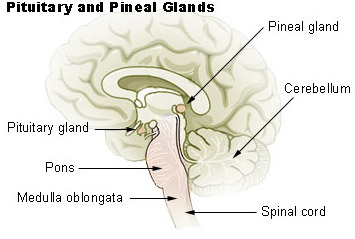Pituitary & Pineal Glands
Pituitary Gland

The pituitary gland or hypophysis is a small gland about 1 centimeter in diameter or the size of a pea. It is nearly surrounded by bone as it rests in the sella turcica, a depression in the sphenoid bone. The gland is connected to the hypothalamus of the brain by a slender stalk called the infundibulum.
There are two distinct regions in the gland: the anterior lobe (adenohypophysis) and the posterior lobe (neurohypophysis). The activity of the adenohypophysis is controlled by releasing hormones from the hypothalamus. The neurohypophysis is controlled by nerve stimulation.
Hormones of the Anterior Lobe (Adenohypophysis)
Growth hormone is a protein that stimulates the growth of bones, muscles, and other organs by promoting protein synthesis. This hormone drastically affects the appearance of an individual because it influences height. If there is too little growth hormone in a child, that person may become a pituitary dwarf of normal proportions but small stature. An excess of the hormone in a child results in an exaggerated bone growth, and the individual becomes exceptionally tall or a giant.
Thyroid-stimulating hormone, or thyrotropin, causes the glandular cells of the thyroid to secrete thyroid hormone. When there is a hypersecretion of thyroid-stimulating hormone, the thyroid gland enlarges and secretes too much thyroid hormone.
Adrenocorticotropic hormone reacts with receptor sites in the cortex of the adrenal gland to stimulate the secretion of cortical hormones, particularly cortisol.
Gonadotropic hormones react with receptor sites in the gonads, or ovaries and testes, to regulate the development, growth, and function of these organs.
Prolactin hormone promotes the development of glandular tissue in the female breast during pregnancy and stimulates milk production after the birth of the infant.
Hormones of the Posterior Lobe (Neurohypophysis)
Antidiuretic hormone promotes the reabsorption of water by the kidney tubules, with the result that less water is lost as urine. This mechanism conserves water for the body. Insufficient amounts of antidiuretic hormone cause excessive water loss in the urine.
Oxytocin causes contraction of the smooth muscle in the wall of the uterus. It also stimulates the ejection of milk from the lactating breast.
Pineal Gland
The pineal gland, also called pineal body or epiphysis cerebri, is a small cone-shaped structure that extends posteriorly from the third ventricle of the brain. The pineal gland consists of portions of neurons, neuroglial cells, and specialized secretory cells called pinealocytes. The pinealocytes synthesize the hormone melatonin and secrete it directly into the cerebrospinal fluid, which takes it into the blood. Melatonin affects reproductive development and daily physiologic cycles.
Suggested Citation
SEER Training Modules: Pituitary & Pineal Glands. U.S. National Institutes of Health, National Cancer Institute. Cited 13 January 2026. Available from: https://training.seer.cancer.gov.




